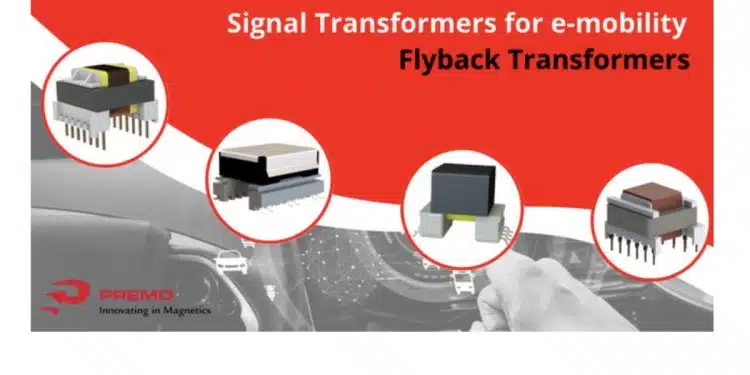PREMO extends its transformer series with FLYT-004 and FLYT-005 products, quasi-resonant mode flyback signal transformer specifically designed for on-board chargers.
Flyback transformers are the most popular choice for cost-effective, high-efficiency isolated power converters from one to tens of Watts power size. The new FLYT-004 and FLYT-005 transformers are suitable for onboard EV/PHV AC/DC battery chargers and have quasi-resonant Flyback mode with a switching frequency of 50kHz – 300kHz and a maximum duty cycle of 85%. They provide high circuit isolation, multiple outputs and the possibility of positive or negative output voltages.
The isolation between primary and secondary windings is a critical feature. The transformer has been designed to withstand high voltage spikes that occur during switching. The transformers are also designed to provide sufficient isolation to meet safety requirements (up to 3kV between windings for reinforced isolation level).
The FLYT-004 has an inductance of 17.5 µH and a power of 10 W. The FLYT-005 has an inductance of 15 µH and a similar power. Both designs are suitable for SMT soldering on PCB (Printed Circuit Board). The specific SMD customized bobbin design guarantees mechanical performance and reliability taking into final size in relation to its nominal power.
OBCs (Onboard Chargers) are typically integrated into the vehicle’s powertrain and require transformers to convert the AC power from external charging stations or home charging units, into the DC (Direct Current) power needed to charge the vehicle’s battery. Flyback transformers are needed for the power supply control unit to provide several different low voltages.
PREMO has developed a fully automatic manufacturing process for this kind of flybacks. The current production, deployed in Vietnam plants is fully automated by using collaborative robots from PREMO RoboticsTM. Due to this high automatization level, the high-volume demand coming from electric and hybrid vehicles is secured with top notch quality levels.































